- FCL Coaches Corner
- Posts
- Coaches Corner: 07/13/25
Coaches Corner: 07/13/25
The importance of nothing. Moving the ball through X. Shooting tips.

Good morning!
Welcome back to FCL’s Coaches Corner. Where we dig into coaching lessons, share resources, and work to grow together. Every other Sunday, we distill ideas we’ve learned from great coaches across all sports, hoping to give you a few tools and thoughts you can bring back to your team.
We took a week off in the end of June as we got swamped in the thick of our event season; however, we are pumped to be back with a newsletter we are excited about today.
Let’s dive in.
(Missed the last Coaches Corner? Catch up here.)
Matt Dunn & Deemer Class
Today’s Menu Includes:
🔦 Coach Spotlight: Nick Saban, the importance of nothing
🧠 Some Outside Inspiration: the Score Takes Care of Itself
🤓 A Trip to the Principles Office: Moving the the Ball Through X
🔥 A Webinar Freebie: Shooting Tips & Corrections
🔦 Coach Spotlight
Nick Saban, The Importance of Nothing
“Let’s talk about the importance of nothing. You get up every day, you’re entitled to… nothing. Nobody owes you… nothing. You could have talent, but if you don’t have discipline, if you don’t execute, if you don’t focus, you get… nothing. If you’re complacent and not paying attention to detail, what does that get you? Nothing.”
Coach Saban has a way of articulating these cultural expectations with absolute clarity. No fluff, just a high standard, delivered directly. What makes this message stick is that it applies to everyone. Talent doesn’t guarantee anything. Titles don’t guarantee anything. What matters is how you show up, how disciplined you are, and how consistently you execute. That mindset doesn’t just build athletes, it builds teams that win when it matters.
Lessons like these are why we love sports. You learn so much more than just how to win a game.
🧠 Outside Inspiration
The Score Takes Care of Itself
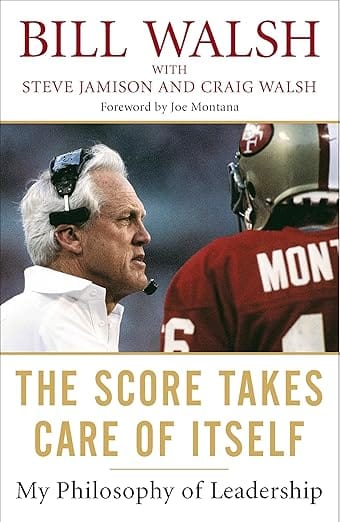 | This book is a masterclass in leadership. Walsh built the 49ers into a dynasty not by chasing results, but by raising the standard for everything from how players practiced to how staff answered phones. His message is simple: if you commit to doing things the right way, with precision and consistency, the wins will follow. It’s a blueprint for any coach looking to build culture, teach discipline, and lead with clarity. Results are the byproduct. The standard is the goal. |
🤓 The Principles Office
Moving the Ball Through X
Welcome back to the Principles Office, where we break down core concepts we believe in and see at the highest levels. This week’s focus: moving the ball through X.
One of the most underdeveloped habits in youth and high school lacrosse is moving the ball through X with confidence and pace. This is something we noticed consistently at our Best in Class events this summer. Even when we created drill environments designed for drifting through X players still hesitated.
Deemer’s tweet below was on the tail-end of our men’s 2028 and 2029 events. It’s something that stands out at higher levels and something younger players consistently struggle with.
One skill every midfielder should be working on this summer:
Throwing it through X - especially with their offhand 🤝
Too many rollbacks are killing the flow of offense!
— Deemer Class (@22classy)
3:40 PM • Jun 24, 2025
It sounds simple. But most players either don’t trust their off hand, don’t understand spacing, or default to the same rollback resets that kill rhythm and make your offense easy to guard.
If you want to build flow, it starts by teaching midfielders and attack to use X as a connector, not a bailout.
Why Throwing Through X Matters
It flips the field. The ball gets from strong side to weak side, and the defense has to shift, recover, and communicate.
It creates time and space. A sharp pass to X pulls help low and buys your backside dodger or shooter an extra step.
It keeps all six defenders honest. Too much same-side dodging leads to stacking and switches. Reversing through X pulls everyone into motion.
It turns defenders and goalies heads. Lacrosse has a unique element of space to play behind the attacking cage. Basketball and soccer don’t have it, and hockey has minimal space. This sets up cuts and keeps heads on swivels.
201 level skillper a college coach:
Throwing it through X with contact on the hip
301 Level:
Throwing it through X with the inside hand
Get to work 🤝
— Deemer Class (@22classy)
5:19 PM • Jun 24, 2025
Why It's So Hard
Moving the ball through X is a decision, but it requires more skill than we give it credit for. Sometimes it’s not as easy as just “throw it through X”. There are a number of factors in play that can actually make this quite challenging:
It’s a challenging pass.
Moving the ball through X in an effective manner requires a hard dodge, threatening the cage, potentially with ball pressure, while reading the defense. Every factor at play here makes this pass difficult to execute. If a player does not feel comfortable and confident in making this pass, they will avoid it.
It may require using your off-hand.
In many scenarios, this requires a player to use their off-hand. Most young players avoid their weak hand. That hesitation slows down the read or leads to the easier rollback.
Players lack gamelike reps in chaos.
This isn’t just a decision. It’s a skill. And like any skill, it needs reps under real pressure. If we are not drilling this skill within the right context (as laid out above), the pass will still feel intimidating in a game. Drills that don’t simulate pressure with contact or force live decisions will not produce the results we desire.
Spacing, dodging angle and passing lane can be tough.
Executing this will require multiple players to be in sync. First, if the ball carrier does not take an appropriate dodging angle, this could make for a very difficult passing lane to X. If the X player is too high, too wide, or not reading the dodge, the option may not even be there. There’s also a world where a defender extends more which affects the play.
Tips and Examples
Clip #1: UVA moves through to feed inside.
A 45 degree or wing dodge often give a better angle for a dodger to feed forward to a player drifting through rather than needing to pop to the ballside. This allows for a quicker field reversal to attack the backside.
Notice how Shellenberger is able to attack the showing defender at X and actually drift through X. This makes the pass more of a forward pass than across the body. The UVA dodge starts more north / south, but then the dodger changes angles to push the pipe.
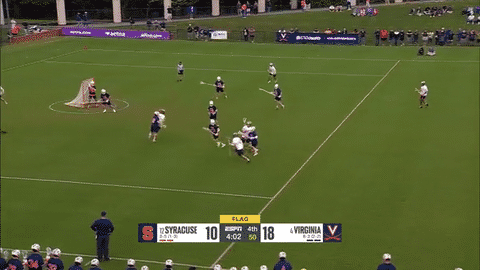
UVA angles dodge towards the pipe, creating a more dangerous passing lane through X.
Clip #2: Maryland moves it through X to feed inside.
Here’s another clip of Maryland moving it through X to hit a cutter on the backside. A few notes here:
Angle of dodge: Erksa on MD (#10) dodges at a 45 degree angle towards pipe, allowing him to step away when he draws the slide.
Depth and timing at X: the X attackman starts deep and gives himself room to drift and essentially start cutting as the dodger is feed ready to move through the ball and push the backside hard. This puts pressure on the defender.
Passing Lane: the combination of these factors creates a favorable passing lane through X.
Attack the backside: as the ball moves through X, UVA is scrambling on the backside which creates opportunities for MD cutters.
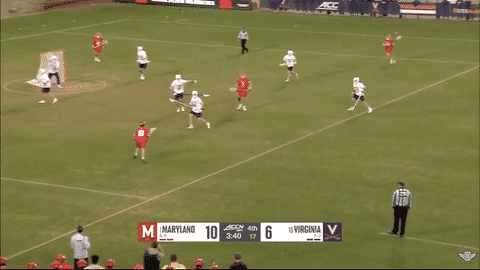
MD pushes the ball through X to hit the backside cutter.
If your team is struggling to get the ball through X, start with dodging angles. It’s a very challenging pass if the dodger starts to fade away.
Clip #3: Maryland moves through X on redodge, swing to step down.
Here Maryland shows how they use X on a redodge. Many offensive players would likely try to force this shot through X. One thing Maryland does such a great job of is passing up lower quality shots to obtain higher quality shots. This usually happens by drawing the defense down by pushing a pipe, hitting X, and then quickly swinging it through to an open shooter.
You can see in this clip how Cornell’s defense collapses so low by flowing with the ball. Utilizing X allows MD to hit the backside before Cornell can recover.
A key tip here is how MD’s X attackmen catches it on the opposite side of the cage ready to swing it ASAP.
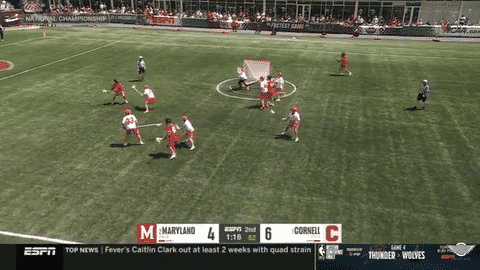
MD beats Cornell recovery by getting the ball through X.
Clip #4: UVA throws inside as Georgetown extends to X.
When a team is skilled at throwing the ball through X, defenses may counter this by extending to X. This can put more pressure on the inside of the defense, particularly the slide guy, since the X defender will not have any adjacent “show” presence.
In the clip below, Georgetown extends to X vs Virginia. This makes sense given how well UVA moves the ball through X and would attack with Shellenberger. You can see the pressure this puts on Georgetown inside to be slide ready and cover up the inside crease action.
Takeaway: if you are good at moving the ball through X, teams will need to solve that problem and vulnerabilities may open up elsewhere.
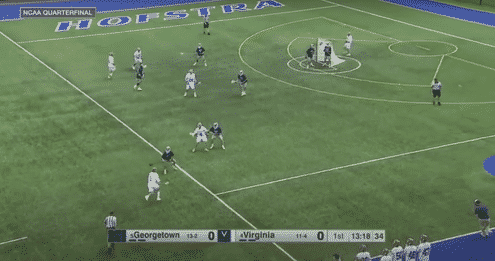
Georgetown extends to X and UVA feeds it inside.
Final Thought
Moving the ball through X requires the right mechanics and mindset.
It takes trust, timing, and intention. We want players to see X not as a reset, but as a weapon. As coaches, it’s our job to create the environment, reps, and standards that bring that vision to life.
Keep demanding it. Keep drilling it. Because the teams that move the ball with purpose are the ones that create real offense.
Until Next Time
Thanks for taking a trip down the hallway. If you are looking for a deeper dive, we have posted numerous videos on our Instagram, Twitter and YouTube channels on this topic.
Stay tuned for more content all spring and email us at [email protected] with any questions and let us know your thoughts.
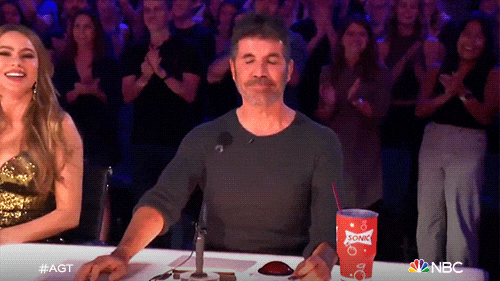
Thanks for tuning in— catch you on our next Coaches Corner.
What did you think of today's email?Contact us directly with more thoughts please! |
🚨 Webinar Freebie 🚨
We believe our coaching community is the best resource on the market for any men’s or women’s coaching staff to continue developing through new drills and strategies. It includes over 30 college coach webinars, 100+ drills for offense, defense and full team compete.
In this week’s newsletter, here’s a video of Tips and Self Corrections around shooting. Deemer has been teaching these core shooting methods since the start of FCL. As we’ve evolved, we thought we’d bring these fundamentals back up. We hope you enjoy, and let us know if this leads to any more discussion or questions.
🔦 COMMUNITY TOUR: Watch Community Tour Here.
🎙️ FCL PODCAST & COACH COMMUNITY
Want to keep sharpening your coaching toolbox?
🎧 Podcast – Check out our free podcast on Spotify, YouTube and Apple podcast.
🔥 Online Community – For coaches who want to level up. Join our men’s and women’s coaching communities for in-depth webinars, drills, and strategy sessions with top college coaches.
